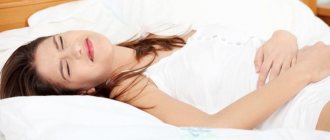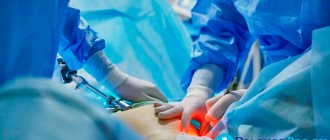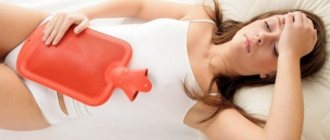If a woman is very attentive to the physiological reactions of her body, then she can accurately tell when her next menstruation will occur and whether she is ovulating this month.
As a rule, before menstruation, a woman begins to feel tightness in the lower abdomen, her mammary glands swell, her mood deteriorates - that is, all the unpleasant symptoms of premenstrual syndrome, known to all girls, appear.
If we are talking about the approach of ovulation, then a woman’s lower abdomen hurts, her breasts swell, become more sensitive, abundant vaginal discharge appears and sexual desire increases.
Why does the lower abdomen pull like during menstruation?
Pulling lower in the abdomen as during menstruation - this condition is not alien to almost any girl or woman.
When a painful feeling appears on menstruation, this is quite normal, since the release of the inner layer of the uterus is associated with active contractions of its body.
This is the essence of the pain syndrome. But if a tugging feeling occurs both during menstruation and in the middle of the cycle, then this already becomes a dangerous circumstance.
The reasons for such symptoms can be very diverse - from PMS to gynecological abnormalities and pregnancy.
What to do if pain occurs in the middle of the cycle?
If the pain in the middle of the cycle is minor, then it can be relieved with the help of painkillers. Ibuprofen, No-Shpa, Ketanov will help. If a woman knows that she regularly experiences ovulatory syndrome, the pill can be taken in advance. On this day, it is necessary to minimize physical activity, drink more fluids, and give up heavy, gas-forming foods.
Sharp, severe pain requires a visit to the gynecologist. You cannot ignore it, because pain can be a sign of a dangerous disease.
Obstetrician-gynecologist, reproductive specialist, lactation consultant, graduated from ChSU named after. Ulyanova with a specialization in gynecology, mammology Read more »
Causes of nagging pain
The female body is built slightly differently compared to the male body. Often women are subject to such difficulties as: disruptions of the menstrual cycle, complications during pregnancy. This is not typical for men.
A painful feeling is not a pathology, but its manifestation.
A painful sensation is always an unambiguous sign. Some representatives of the fairer sex endure this pain, while others simply cannot. If there is a pulling feeling in the lower abdomen, it is necessary to determine the main cause.
For these purposes, it is necessary to collect all descriptions of the patient’s pain syndrome and establish a preliminary diagnosis:
- The main thing that a gynecologist must do is to establish the nature of the discomfort. It can be mild, moderate or strong. He can torment the patient constantly or systematically.
- Of fundamental importance is such a point as dependence on the menstrual cycle. A painful, nagging feeling can occur several days before, during, or after menstruation. Pain is often felt during ovulation.
- It is important to determine the connection between pain and the process of urination, bowel movements, and eating. Pain may occur at rest or during walking and active movements.
- By location, discomfort is identified in the left or right area below the abdomen, blurred, bilateral. Not many people realize exactly why the lower abdomen feels tight. These etiological reasons can be hypothetically divided into pathological and, of course, physiological.
The lower abdomen hurts with diseases such as:
- Frequent urination;
- Salpingo-oophoritis in the chronicle;
- Endometritis;
- Excessive growth of the inner layer of the uterus;
- Infectious pathologies;
- Deviations in the formation of the genital organs;
- Pyelonephritis;
- Intestinal diseases;
- Diverticulitis.
Natural physiological factors include stress, pregnancy, premenstrual time, freezing, changes in sexual life, and the timing of ovulation.
Pulling in the lower abdomen after ovulation
It is no secret that during any menstrual cycle, an egg matures, leaves the place of maturation and moves to the location of the uterus, fully prone to fertilization, and then is rejected with a certain amount of blood if conception does not take place.
In medical practice, this natural phenomenon is called ovulation, the process of opening of the follicle and release of the egg, which actually becomes a microtrauma for the woman’s body, and according to physiological principles can be associated with painful manifestations.
A pulling feeling, which manifests itself more strongly on one side and then on the other, is often interpreted as the rapid maturation of the egg in one of the ovaries.
The causes of nagging pain following ovulation, if conception is unacceptable, may be as follows:
- inflammatory phenomenon in the area of the reproductive organs;
- critical gynecological problems (violation of the integrity of the cyst, torsion of the pedicle of the neoplasm of the mucous membranes, etc.);
- frequent urination;
- significant fatigue and weakening of the body;
- signs of appendicitis.
Normally, there may be pain, which is established in the context of the so-called postovulatory description of the condition - it is not so common and is diagnosed only in every 7-9 patients.
Due to changes in hormonal levels, the following signs may become relevant:
- painful feeling and heaviness in the lower abdomen;
- slight deterioration in health;
- increased libido;
- uncharacteristic vaginal discharge.
Pulling in the lower abdomen a week before menstruation
Discomfortable sensations some time before menstruation usually indicate various abnormalities.
Possible factors for this condition may be:
- the appearance of dense formations in the body of the uterus;
- unexpectedly sharp jump in hormone levels;
- the result of physical injury;
- response to inflammatory phenomena in the pelvic area;
- failure of the menstrual cycle , resulting in delayed ovulation - in this case, nagging pain occurs for a short time;
- Taking into account the close location of the gastrointestinal tract organs, pain in this location can become a manifestation of difficulties in the intestines. In this case, additional symptoms will include rumbling and slight bloating;
- About 7 days before, a pulling sensation may appear in the lower back and abdomen, after which menstruation does not appear on time. In such a circumstance, the sensations become a symptom of delay, which is caused by a disorder in the functionality of the ovaries, disturbances in the hormonal ratio;
- One cannot ignore the possibility of pregnancy - implantation of an egg to the uterine wall can be associated with minor discomfort and even spotting bleeding. It is necessary to mention that if conception has occurred, and the pulling sensation is characterized by excessive intensity and transforms into obvious and unbearable pain, then you must immediately contact a gynecologist, since such increased tension in the uterus can become a factor in the termination of pregnancy.
Let's understand the term "ovulation"
The duration of the menstrual cycle is determined from the first day of the previous menstruation to the first day of the next. Its duration varies and normally ranges from 21 to 35 days. The ideal menstrual cycle is considered to be a cycle lasting 28 days, which corresponds to a full lunar cycle. The menstrual cycle consists of several phases:
Follicular phase
The follicular phase is caused by the action of estrogens, under the influence of which a dominant follicle is determined in the ovary, in which the future egg matures. This phase lasts an average of 12–18 days, depending on the length of the cycle. With a 28-day period it is 14 days. Towards the end of the follicular phase, the dominant follicle has reached its maximum development, is tense and is preparing to burst.
Ovulatory phase
The shortest phase of the menstrual cycle, its duration is 12 – 36 hours. During this phase, estrogen levels drop, causing the main follicle to burst and release a mature egg, ready for fertilization. What is characteristic is that it is during the ovulatory phase that the level of both estrogen and progesterone is quite low (estrogens are no longer synthesized, since the dominant follicle and egg have already “matured”, and progesterone is not yet produced in sufficient quantities under the influence of luteinizing hormone due to the still unformed corpus luteum in place of the main follicle).
Luteal phase
The synthesis of progesterone increases, under the influence of which proliferative processes occur in the uterine mucosa, preparing it for implantation of a fertilized egg.
In the case of unsuccessful fertilization, by the end of the luteal phase, the level of progesterone decreases (the corpus luteum of menstruation dies) and the functional layer of the endometrium is rejected, which is called menstruation. So, ovulation is nothing more than the process of the release of a mature egg from the dominant follicle at the moment of its rupture. And painful ovulation is called ovulatory syndrome or Mittelschmertz syndrome.
Diseases in which the lower abdomen pulls as during menstruation
It is an undeniable fact that nagging pain is just part of the symptom complex of the disease, that you need to listen to your own condition.
Thus, a number of probable gynecological factors for nagging pain in the lower abdomen include:
- inflammation spreading in the uterus or its processes;
- myoma;
- endometriosis;
- torsion of an ovarian cyst;
- ectopic pregnancy;
- the appearance of blood in the ovarian cavity (apoplexy).
All of the mentioned conditions require timely diagnosis and treatment; in the opposite situation, it is likely that the condition will worsen and threaten consequences for women’s health.
Inflammation of the appendages
If during critical days the right side below the abdomen hurts, one cannot discount the occurrence of an inflammatory process in the appendages.
Menstruation is also a stimulus for exacerbation or initial development of the disease.
Pain syndrome manifests itself in the sacrum, inner thighs, lower back, and in some cases in the rectum.
Sometimes pathology can be determined inside both appendages. However, it may further be felt on the right side if the pathological process is more intense in this area.
Its distinctive descriptions:
- there is more mucus in menstruation, the appearance of pus is not excluded;
- feeling tired and drowsy;
- no appetite;
- Nervousness and irritability arise.
The painful sensations themselves, despite the fact that they are quite sensitive, are still not so significant and intense when compared with what occurs with other pathologies.
Myoma
The location of the myomatous node in a certain area of the uterus can also become a factor in pain during menstruation in the right side below the abdomen.
Typically, this neoplasm reacts to the female sex hormone.
During menstruation, their degree of presence decreases, but immediately after the end of the critical days their increase begins.
Uterine contractions, which provide release from the outdated inner layer, disturb the fibroid and nearby nerve endings.
The neoplasm itself creates obstacles to the amplitudes of the organ. This is what causes complaints that during and after menstruation a painful feeling occurs in the lower abdomen on the right, the volume of discharge during menstruation increases, which ends in a long-term spotting.
Endometriosis
Quite often there is pain in the lower abdomen with a pathology such as endometriosis. This disease accounts for 10% of all episodes of gynecological abnormalities. In any representative of the fairer sex, the reproductive organ is lined from the inside with an inner layer - the endometrium.
The disease endometriosis is characterized mainly by excessive growth of the layer and its extension beyond the border of the uterine mucosa. Women in the age group from 30 to 50 years are often susceptible to this deviation.
The following causes of endometriosis have been established:
- loss of the optimal ratio of produced hormones (higher levels of follicle-stimulating and luteinizing hormone);
- genetic predisposition;
- decrease in the body's defenses ;
- metaplasia (growth of one tissue structure into another).
The predetermining factors of this pathology are:
- Presence of a history of abortion;
- Harmful environment;
- Iron deficiency;
- Gaining excess weight;
- The presence of chronic inflammation of the genitourinary and reproductive systems;
- Use of intrauterine devices.
Endometriosis does not have stable clinical symptoms. The most common signs are pain, vaginal discharge, nausea, vomiting, weakening of the body, and failure of reproductive activity.
When is urgent medical attention needed?
A woman needs to consult a doctor as soon as possible or call an ambulance if she notices the following symptoms:
- body temperature rises steadily;
- pulls the lower back in the middle of the cycle for a long period of time (more than 24 hours);
- feeling sick, feeling the urge to vomit;
- the ovary constantly hurts, the patient’s condition continues to deteriorate;
- a woman may suddenly faint;
- bleeding occurred (regardless of the intensity of the discharge);
- the patient has undergone gynecological operations or diseases of the reproductive system in the past;
- the ovaries hurt while taking medications to stimulate ovulation.
Problems with women's health, even if they seem completely harmless and insignificant, should be addressed by a specialist. Self-medication is strictly prohibited! This can result in serious problems for a woman. At best, they may be related to the functioning of the reproductive system. Some pathologies can threaten the patient’s life and require emergency surgery.
Non-gynecological reasons
With a normal balance of hormones, women do not feel discomfort during any period of the menstrual cycle. When a woman experiences a painful feeling similar to that which accompanies menstruation below the abdomen and back, the cause is prostaglandins.
This hormone, when produced by the body in excessive quantities, affects the contraction of the uterine muscles, causing a feeling of pain. With such a malfunction of the functionality of the female body, nagging painful sensations often occur after the end of menstruation.
Such a hormonal imbalance is provoked by an increase in the activity of the thyroid gland. As usual, other symptoms are added, more precisely, sleep disturbances, weight gain or loss, and so on.
In addition, the use of hormone-modulating drugs can affect the ratio of hormones. In such a situation, you should contact a gynecologist with a description of the symptoms that have arisen.
Appendicitis
The inflammatory process in the appendix can also be characterized by nagging painful sensations in the lower abdomen, similar to the start of menstruation.
This manifestation is the result of a shift in the location of the painful feeling.
Pain on the right side may not only be due to difficulties in the reproductive sphere.
The period of menstrual discharge is characterized by a decrease in immunity, a large number of symptoms that change the activity of other organs, more precisely the gastrointestinal tract. And for this reason, all the signs may indicate the following diseases: Appendicitis.
The trigger for the process of inflammation of the intestinal appendix in the form of a worm is often poor nutrition. Since some female representatives have a good appetite during menstrual periods, they consume a lot of spicy and sweet foods, which provokes disruption of the intestines.
The result of this may be an inflammatory process in the appendix. A sharp painful sensation appears first in the middle of the abdomen, after which it spreads to the right side.
Other signs:
- vomiting just once
- diarrhea,
- feverish increase in temperature.
The painful feeling subsides when lying on the right side.
Tightening in the lower abdomen after sex
A painful sensation in the lower abdomen can also occur after sex.
There is no need to worry about this phenomenon; it is considered normal.
Each sexual intercourse is, although insignificant, an injury to the mucous membrane of the vagina, and in some situations, in particular after violent sexual intercourse, these injuries appear much more pronounced than always.
There is an aching, nagging painful sensation, possibly even the appearance of brown spotting, which occurs if there is a violation of the integrity of the mucous membrane (this is thickened blood).
There is no need to worry about pain of this nature - and alternatively, be a little more careful in your sex life.
Thus, for the most part, circumstances when a female representative has a tightening in the lower abdomen require consultation with a doctor, and perhaps subsequent treatment measures. If the painful feeling does not recede but, on the contrary, worsens, then you must immediately go to the gynecologist.
Other diseases of the abdominal cavity and pelvis
The organs of the reproductive system have a lot of “neighbors”, the pathologies of which are well masked behind abdominal pain. And often a woman associates them with cyclical changes. However, we must not forget about the organs of the urinary and digestive systems.
Appendicitis with an unusual location can cause severe pain in the lower abdomen, especially on the right. Surgical help is necessary if, in addition to severe pain, you feel heaviness in the stomach, lack of appetite, fever, nausea and vomiting.
Pyelonephritis is an inflammatory disease of the kidneys. The pain can be localized on one side, spread to the lower back and back, or be girdling in nature; fever and severe intoxication are observed.
Cystitis, urethritis. If urination causes pain, there is tenderness in the lower abdomen, or a slight increase in body temperature should prompt you to seek medical help.
Listen to your body, because it is a very complex system that is capable of self-regulation and timely signaling of problems. Understanding your body's messages will allow you to live a longer life and enjoy every moment of it.
Author Maria Semenova Reading time: 13 min. Published 01/13/2018
Often women, when visiting a gynecologist, voice complaints that they have a tugging lower in their abdomen. A nagging manifestation can be a sign of many diseases. However, not in all cases the painful manifestation is a sign of some pathology.
Women and young girls experience this syndrome during menstruation or before it appears. When the pain persists and is complicated by other complaints, a consultation with a gynecologist is necessary.
What are the root causes of pain in the lower abdomen in females and how to get rid of them?
Prevention
When there is a pull in the lower abdomen before the onset of menstruation, you must follow simple instructions to avoid this:
- Exercise before your period. Swim and stretch your lower back;
- Avoid overeating. Heavy weight provokes pain;
- Breathe deeply with clean air, take vitamins, avoid smoking and alcohol.
Severe, growing pain simply cannot be tolerated. At initial signs, it is better to consult a doctor.










